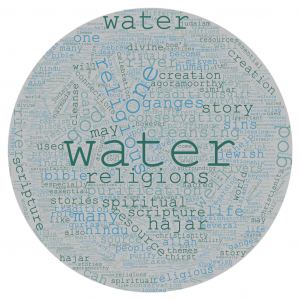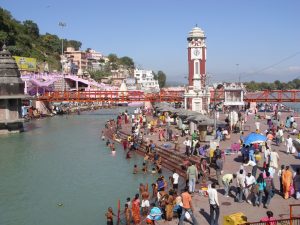57 The Sacredness of Water
Hallie Stelzle

Hello! The idea for this paper originated from a simple reflection on the importance of water in our everyday lives – both in a physical and spiritual sense. With climate change exacerbating water issues worldwide, I decided to dig into our long standing relationships with water through the lenses of four major world religions to try to better understand what water means (and has meant) to people throughout time, in hopes of finding potential spiritual or religious motivations for water conservation…read more.

Pick up any religious text and you are likely to find at least one reference to water. Whether it is used to cleanse, bathe, heal, restore, replenish, or purify: water is one of the most prolific symbols in major world religions, stretching through time, place, and culture. As human beings, this may come as no surprise seeing how our bodies are composed mostly of water, and we rely on it for our very survival – a truth that continues to become more resonant as the effects of climate change take hold in the forms of drought, rising temperatures, and natural disasters. Like many religious symbols, water appears in scripture, ritual and tradition through its simplicity and use in everyday life. In examining a variety of major world religions, namely Islam, Judaism, Hinduism and Christianity, connections between water as a common resource, and water as a sacred and holy gift become apparent. Drawing from these unique and similar understandings of water, we can begin to consider the spiritual motivations one might have in engaging in water conservation efforts. Furthermore, in exploring these religions specifically, we can identify some beliefs about water that may provide helpful wisdom in the face of more rational conversations surrounding water conservation. Because these religions have such strong relationships with water and large followings worldwide, there is hope that these connections between scripture and our contemporary crisis may be brought to life to move toward a more secure and just future.
As stated previously, it is nearly impossible to get through a religious text from any of these major world religions without running into some story or significant mention of water. If human beings have required water since the dawn of time, we certainly have written about it since then too. In fact, most creation stories deal heavily with the idea of water as a main source of life. The Abrahamic religions (Islam, Judaism, and Christianity) for example, all discuss the works of God or Allah in their creation stories, and the essential role of water in that formation of life. The creation story of the Qur’an illustrates the majesty of creation through the life-giving properties of water, stating: “…In the water which Allah sent down from the Heavens and brought with it life to Earth after being dead and gave life in it to every kind of land animal…” (Qur’an 2:164). Water is described similarly in the book of Genesis in the Bible: “Then God said: Let the water teem with an abundance of living creatures, and on the earth let birds fly beneath the dome of the sky” (Genesis 1:20). In the Hebrew Bible as well, the “primordial deep” or tehom is described as “…the basic source out of which all Creation emerges (except for humanity)” (Troster, 2011). The key role of water in creation stories is not unique to the Abrahamic religions either. According to the Hindu sacred text, the Rigveda, the water on earth came directly from the heavens (similarly to how it is described in the Qur’an). Lord of heaven, Indra, killed the snake that was hoarding the water in heaven, allowing it to flow freely in rivers on earth, nourishing those who drank it (Agoramoorthy, 2014). While unique in the specific details, each of these religions place emphasis on water as an essential component of their creation stories, noting its ability to bring forth or restore life. These themes of birth, rebirth, and restoration will come back into the conversation about water later, especially in the context of rituals and traditions.

Outside of creation stories, water continues to play a key role in religious texts through its status as a common, everyday substance which is needed for agriculture, cleansing, and consumption for survival. Like most living things, humans have had a tendency to settle near large bodies of water such as rivers, lakes, and oceans, understanding the multitudes of benefits the water would provide. In Hindu scripture, the importance of India’s rivers is emphasized through their inherent connections to Hindu gods and deities. The Ganges River, located in the northeast region of India, has ancient connections to the Lord Shiva – the god responsible for destruction and regeneration. The Narmada River, located in India’s northwest region has sacred ties as well, with proverbs citing its sin-purifying properties, even just by looking at it (Agoramoorthy, 2014). Religious connections to geographic features and weather are present in Jewish scripture as well. Instead of the Ganges or Narmada, the Hebrew Bible often includes stories about the Nile River,[1] and draws comparisons between Egypt and Israel to reflect upon their different relationships with God. In Deuteronomy 11:10-17, Moses tells the Israelites: “The land you are about to enter is not like the land of Egypt from which you have come, where you would sow your seed and then water it by hand…”. He goes on to say that Israel is a place which has no such steady water source, and instead relies on rainwater from the mercy of God. In verse 13, Moses says (from the point of view of God): “If then, you truly listen to my commandments…loving and serving the Lord, your God…I will give seasonal rain to your land…” From this chapter, it is understood that water is a reflection of the Israelites’ covenant with God. Only their love and trust in God would assure that they were granted water, unlike in Egypt where people had a constant source and therefore had “human independence from divine constraints” (Troster, 2011).
While water is explained as essential to survival, it is also not guaranteed, and must be considered a gift – an important consideration when thinking about water conservation, and how we often take it for granted. While the symbols of the river differ between these specific examples from Hinduism and Judaism – one reflecting great divinity and the other representing a disconnection from God – there is a great similarity between these religions in the way they view water as a tool to cleanse one of sins. As mentioned above, several rivers in India have high spiritual significance, especially in their healing capabilities. In Jewish scripture, water is constantly called upon to perform acts of purification – whether literal or spiritual. The book of Leviticus includes many examples of when water is used for cleansing purposes, including (but certainly not limited to) after childbirth/menstruation, disease, and purification after being in contact with an animal or human corpse (Leviticus 1-15). Water is also used to purify someone of their sins, as seen in Micah 7:18-20 of the Hebrew Bible: “And You will hurl all our sins into the depths of the sea” (via Troster, 2011). These interactions with water in Jewish scripture highlight the resource as an important tool for maintaining a good relationship with God through covenants, purification practices, and self-purification in a physical and moral sense. Water, here, is both a gift from God, and a medium through which one can connect with Him.
While the Hebrew Bible differs in several ways from the Old Testament of the Bible, the foundation and scripture is largely similar, and the two religions share much of this literature. In this way, it makes sense that Christianity and Judaism have many similar views and traditions surrounding water. Continuing with the theme of cleansing, the New Testament of the Bible (the portion of the Bible that diverges from Jewish belief) contains many stories about using water to cleanse physically, and to wash away sins spiritually. One of the more notable appearances of water in the Bible is at Jesus’ baptism at the Jordan River. After being baptized by John the Baptist, Jesus, “came out up from the water and behold, the heavens were opened [for him] and he saw the Spirit of God descending like a dove [and] coming upon him. And a voice came from the heavens, saying, “This is my beloved Son, with whom I am well pleased”” (Matthew 3:16-17). This excerpt identifies water, again, as a connective medium between humans and the divine. Jesus’ act of baptism and approval from God is similarly reminiscent of the texts from the Hebrew Bible regarding God’s covenant with the Israelites. In different ways, water is depicted as a unitive tool used to improve or repair one’s relationship with the divine.

Another well-known biblical mention of water is the story of the Samaritan woman. In his passing through Samaria, Jesus, tired from his journey, stops at a well and asks a Samaritan woman for a drink. Shocked at this request, she inquires as to why he is asking (as this is a socially unacceptable thing to do in this time/circumstance). Jesus, in response to her doubts and refusal to help says, “Everyone who drinks this water will be thirsty again; but whoever drinks the water I shall provide will never thirst; the water I shall give will become in him a spring of water welling up to eternal life” (John 4:13-14). Water, in this story, takes a few different forms and meanings. It is represented, of course, as a basic need; Jesus stops to take a drink after his long travels, and the Samaritan woman relies on the well as her primary water source. In Jesus’ message to her, however, the ideas of “thirst” and water are used in a metaphor for the life-sustaining properties of trusting and obeying God. In the same way that water quenches one’s physical thirst, so can the mercy of God quench one’s spiritual “thirst”.
Fitting in nicely with the themes of thirst and trust is the story of Hajar from Islamic scripture. Throughout the Qur’an, as with the other religious texts presented, water serves as a major theme, especially in the contexts of purification tradition and blessing, and much like in many biblical/Hebrew scriptures, is discussed under the pretense of scarcity. The story of Hajar combines this very practical challenge of water scarcity with displays of great perseverance, gratitude, and blessing. Hajar, an Egyptian handmaid and wife of the Prophet Ibrahim, sits with her young son and husband underneath a tree in the water scarce city of Makkah. With little to eat or drink, her husband informs her that he is being called by Allah to depart from their camp, leaving Hajar and son to their own devices. Because of her trust in Allah, Hajar accepted Ibrahim’s decision and returned to the camp alone to take care of her son. As time passed however, food and water ran short, and Hajar became worried for the health of her child. In her desperate search for water, she climbed Mount Marwa seven times in hopes of finding someone who could help. After her seventh climb, an angel appeared to Hajar, and as she watched on, the angel dug a hole in the ground with their wing, and a spring of water came flowing out. Hajar formed a basin around the water to collect it, and filled her canteen with the water that had been provided. This site is now known as Zamzam, and plays a critical role in Islamic traditions today (Ahmad, 2015). The story of Hajar is revered, and outlines several key messages regarding water in the Islamic faith. Here again, we see the experience of thirst as Hajar struggles to find water for her child and herself with few to no resources available. In this lack of resource comes the theme of faith – trusting in Allah to provide strength and to carry them to a source of nourishment. Finally, the joyous blessing of water is brought forth by the angel on the mountain who dug the Zamzam well. Water as a gift is represented through this story once again as a resource that is desperately needed, but never truly guaranteed – making the availability of water (sent from Allah) a true, blessed gift indeed.

The story of Hajar is just one of many scriptures which divulge into themes and traditions surrounding water; however, it is one of the foundational stories upon which the hajj pilgrimage is based. Once a year, millions of Muslims from around the world make the pilgrimage to Mecca, Saudi Arabia to partake in the ceremonious tradition of hajj. The five to six day event includes a variety of symbolic rituals, including a counter-clockwise walk around the Kaaba seven times, a run between the hills Safa and Marwah which Hajar walked (seven times also in accordance with the story) and a visit to the Zamzam well where Hajar built the basin and replenished her water source (BBC, 2020). Some Muslims even take home some of the water from the Zamzam well as they depart, viewing it as a precious and holy resource (Ahmad, 2015).
Beyond the great pilgrimage to Mecca, there are many examples of how water is used in Islamic practices and traditions today in everyday situations. A few such practices pertain to the cleansing of one’s self before prayer, also known as the ablution rituals of wudhu and ghusl. These rituals are intended to prepare the individual for prayer in a way that respects Allah. A verse from the Qur’an discusses this purification practice: “O you who have believed, when you rise to [perform] prayer, wash your faces and your forearms to the elbows…Allah does not intend to make difficulty for you, but He intends to purify you and complete His favour upon you that you may be grateful” (Qur’an 5:6 via Ahmad 2015). The purification practice here once again demonstrates the power of water to connect the individual to the divine through cleansing, preparation, and gratitude.
Modern traditions related to water-related scriptures are seen throughout Christianity as well. One example of many is the practice of baptism – the cleansing of sins in holy water or natural water source with a blessing. For some Christians, baptism occurs during infancy or young childhood, to wash away “original sin” or the sins inherently bestowed upon an individual as descendants of Adam and Eve who created the first human sin. Other Christians, who either were not baptized in youth or who choose to convert to Christianity, sometimes decide to become baptized later in life. This event similarly cleanses original sin, and the personal sins accrued over the course of one’s life. Baptism handles water in a similar way to the other discussed religions – to purify, clean, and accept or open a relationship with the divine. The tradition can create for the individual a connection with God through the renunciation of sins, acceptance of faith, and ultimate dip into the holy/blessed water.
Full body immersion rituals appear in Jewish tradition as well. One such example is the immersion in the mikveh or ritual bath. Located in most Jewish communities, the mikveh is a small indoor pool/bath where some Jewish folks come to partake in a full body immersion in the water. Most commonly, people immerse in the mikveh during conversion to Judaism, before marriage, or as a menstrual purification ritual for married women, however these are not the only reasons people participate. More recently, Jewish folks have used the mikveh to mark important milestones in their religious and personal lives such as before a bat or bar mitzvah, before Yom Kippur, or even during recovery from a painful or traumatic event (Lockshin). In one account, a woman details her experience from using the mikveh as part of her recovery from severe depression. She explains the process of the ritual and the meaning it carries for her, saying: “I then allowed the water to cleanse me, not my physical body, but my mind and my heart… As the water surrounded me with warmth and comfort, I closed my eyes and let the water cover me. I felt protected and whole” (Sugarman, 2015). The beautiful words from this article illustrate some of the powerful impacts immersion in the mikveh bath can have, and furthermore add new ideas to the meaning of water in religious contexts. Sugarman’s use of the phrases “warmth and comfort” and “protected and whole” give additional significance to the idea of water as a nourishing and cleansing medium, in connecting it to a deeply personal and spiritual experience facilitated by a full body immersion in holy water.

The practice of cleansing in sacred waters extends into contemporary Hindu traditions as well. As stated earlier, several of India’s rivers are revered for their religious significances and have traditions and celebrations associated with each. The rituals and traditions surrounding the rivers Ganges, Narmada, and Cauvery are alike and different in ways that demonstrate some key themes about water from the perspective of the Hindu faith as celebrated in India specifically. Many of these celebrations are based on Hindu scripture and mythology regarding the actions of gods, and often pertain to the cleansing of sins because of the rivers’ sacred connections. The Ganges, one of the most revered holy rivers in India, for example, is believed to contain amrit (the nectar of immortality) from a victorious battle and celebration of the gods in Hindu mythology. Today, as a result, the Ganges is celebrated as having purifying abilities, and is the site of Kumbh Mela, a pilgrimage which takes place every twelve years in accordance with the myth, where participants immerse themselves in the Ganges for its cleansing properties (Agoramoorthy, 2014). In recent years however, the Ganges has become immensely polluted, a result of industrialization and untreated sewage flow. There exists a diversity of opinion among practicing Hindus in India regarding the river’s ability to cleanse amidst this pollution, and the role humans should play in restoring it (if at all). Many Hindus are in favor of intervention, viewing the pollution as both harmful to human health, and disrespectful to Ma Ganga (Mother Ganges). Other Hindus believe in the river’s ability to cleanse and purify herself, and some thus perceive efforts to clean the Ganges as pointless in the face of such great divinity (Harvard Divinity School, 2018). These perspectives about the Ganges, of course, are not the only ones held by Hindus in India, but they do serve to demonstrate the complexity of this issue in regards to religious beliefs, and the diversity of thought that can exist within any one religion.

The Narmada has a similar celebration related to cleansing called Pradaksina, a pilgrimage in which participants walk 1,600 miles along the Narmada in repentance of sin (Agoramoorthy, 2014). The Cauvery River, located in south India, once again carries this theme of purification, but with an additional component of motherhood and fertility. One version of the myth associated with this river and tradition tells the story of Vishnumaya, a woman who, in gratitude to her adopted father turns into a river (the Cauvery) to cleanse people of their sins. Today, this river is the site of Patinettam Perukku – a celebration honoring the river and all she provides. The name of the celebration, Patinettam Perukku, translates to “pregnancy cravings”, thus portraying this river as a maternal figure that brings forth fertility and life as suggested by the myth. As part of this celebration, food is tossed into the water as an offering, to satiate the “cravings” mentioned in the name (Agoramoorthy, 2014). Water represented in this maternal light offers an interesting suggestion about its properties and about our relationship with it. Much like how we rely on our mothers for survival at a young age, we rely on water throughout our entire lives. This interpretation of water reinforces the vital theme of dependence; our reliance on water is something which may help us remember how utterly human and limited our control and powers are.
Powerless though we may be, it has not stopped us from trying. Our constant search for control and ceaseless efforts to manipulate our environments has led our planet into a state of crisis. Through the increase of industrialization, and immense decrease of natural forested spaces, our global carbon emissions have largely overshot maintainable levels, leading to multitudes of challenges ranging from melting glaciers in the arctic, to forest fires in Australia and the American west, with thousands of crises in between. High on that list of crises is water, especially when we consider that “more than 2 billion people live in countries experiencing high water stress” (United Nations, 2018). Not only is nearly one third of our human population living in countries of water scarcity, much of this water is not suitable to drink. A World Health Organization (WHO) study estimates that contaminated drinking water is responsible for 485,000 deaths yearly (WHO, 2017). Even the Ganges River, as noted previously, has become “profoundly polluted with toxic waste” (Agoramoorthy, 2014) making it unsafe to drink and bathe in as desired.
Looking at just this short list of problems, it feels overwhelming to find solutions in a timely manner, if even at all. Many of these issues are systemic, branching from harmful ideologies of colonialism and capitalism, which often disregard the interests of people and environment, favoring the pursuit of wealth, influence, and power. This striving for control has led us to a position of peril, one which will only be overturned once we start to realize that we are not as powerful as we have made ourselves believe. These interpretations of water through various religions may help us arrive at that point, and may furthermore provide tangible motivations for religious folks to actively protect this resource in the first place.

While varying in scripture, tradition, and belief, these four religions share many common ideas about water as a resource and as a spiritual symbol and tool. First and foremost, water is expressed as a basic need, something understood to be essential to our survival on earth. From this understanding, water is seen as a gift from the divine, either expressing some covenant with God, or Allah, or perhaps demonstrating the mercy of several gods in freeing the water from heaven. This heavenly understanding of water in combination with its meaning as an essential resource gives it a key role in many purification practices, used to prepare one for prayer, or a large commitment such as marriage. Water purification rituals also function spiritually in the completion of a mandatory pilgrimage, or in the cleansing of sin.
With these themes in mind, we can consider how spiritual motivations may play a key role in garnering water conservation support from religious groups. In fact, this consideration need not be theoretical as such religious water efforts already exist and are drawing from these themes in their activism. Take for example the humanitarian organizations Muslim Hands and Islamic Help, two groups each working to bring sustainable sources of water to communities around the world – acting on behalf of Allah’s message regarding the importance of giving the gift of water to others (a message that is told through the story of Hajar as well.) Another example from the United Methodists’ website details ways in which Methodists can get involved in water conservation, including actions such as shortening showers, and designing water-efficient landscaping in an attempt to be better stewards of God’s creation (Iovino, 2017). Similar messages about water conservation were taught to students through Jewish National Fund’s Rainwater Harvesting Program in Israel to help promote water-saving activities at schools, especially in the context of drought – another prominent reminder of the uncertainty that exists in water availability. Thinking more along the lines of water quality, restoration efforts have begun in India via the ‘Save Ganga Movement,’ which has garnered much support from Hindu monks and spiritual leaders in a push for river cleanup (Agoramoorthy, 2014). Beyond the Ganges, water conservation continues to be a priority in Hindu communities around the world. One program from 2007, “Hinduism and H20,” aimed to increase conservation efforts within several Hindu communities in the East London area by connecting religious beliefs about water with environmentally friendly behaviors.

It’s worth emphasizing that despite some key ideological differences between these religions, water stands out as a uniquely common symbol. Shared ideas about water have the capacity to unite religions, and water itself unites us as living things too – we are bound together by our need for water. These religions each have a different way of showing us why water is important – for reasons of survival, obviously – but also in more spiritual contexts through demonstrations of relationships, purification, mercy, and grace. These spiritual understandings of water, furthermore, make a compelling case for religious folks as water activists. Beyond seeing water as a vital resource, people who have a spiritual perception of water can appreciate it for its intrinsically holy qualities, which may very well provide a strong incentive for conservation activities. Arguably, these religious ideas could even be considered in more secular water conservation spaces. Whether one believes in a divine connection, or is simply in awe of water’s ability to freeze, boil, and continue through a cycle spanning millions of years, there is something to be said for water as a sacred substance. In one way or another, looking beyond the surface of this resource may help us all see its sacredness more clearly.
References
Agoramoorthy, G. (2015). Sacred Rivers: Their Spiritual Significance in Hindu Religion. Journal of Religion & Health, 54, 1080-1090.
Ahmad, H. (2015). Islam and Water: The Hajjar (r.a.) Story and Guide. Global One, 1-18.
BBC. (2020). What is the Hajj Pilgrimage? BBC Newsround. Retrieved from https://www.bbc.co.uk/newsround/24566691
Creation Justice Ministries. (2014). Water, Holy Water. Creation Justice Ministries, 1-7. Bulletin PDF. Retrieved from https://www.creationjustice.org/earth-day-2014—water-holy-water.html
Harvard Divinity School. (2018). Pollution and India’s Living River. Religion and Public Life – Harvard Divinity School.
Iovino, J. (2017). A Christian calling: Save water, save lives. United Methodist Church. Retrieved from http://ee.umc.org/what-we-believe/a-christian-calling-save-water-save-lives
Lockshin, S. What Is A Mikveh? My Jewish Learning. Retrieved from https://www.myjewishlearning.com/article/the-mikveh/
Sugarman, R. (2015) Marking My Recovery in the Mikveh. My Jewish Learning.
Troster, L. (2011). Jewish Teachings on Water. GreenFaith Water Shield, 1-4. PDF. Retrieved from www.greenfaith.org
United Nations. (2018). Water and Climate Change. UN Water. Retrieved from https://www.unwater.org/water-facts/climate-change/
World Health Organization. (2019). Drinking Water. World Health Organization. Retrieved from https://www.who.int/news-room/fact-sheets/detail/drinking-water
- Parallels might be drawn to the biblical account in Gen 2:6, 10+ where the garden of Eden is linked to rivers. ↵
